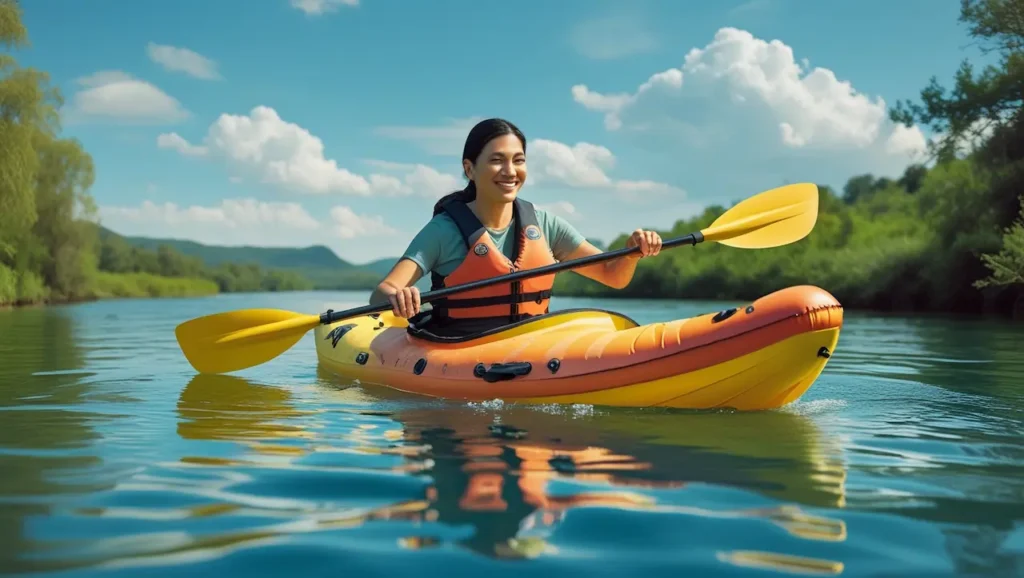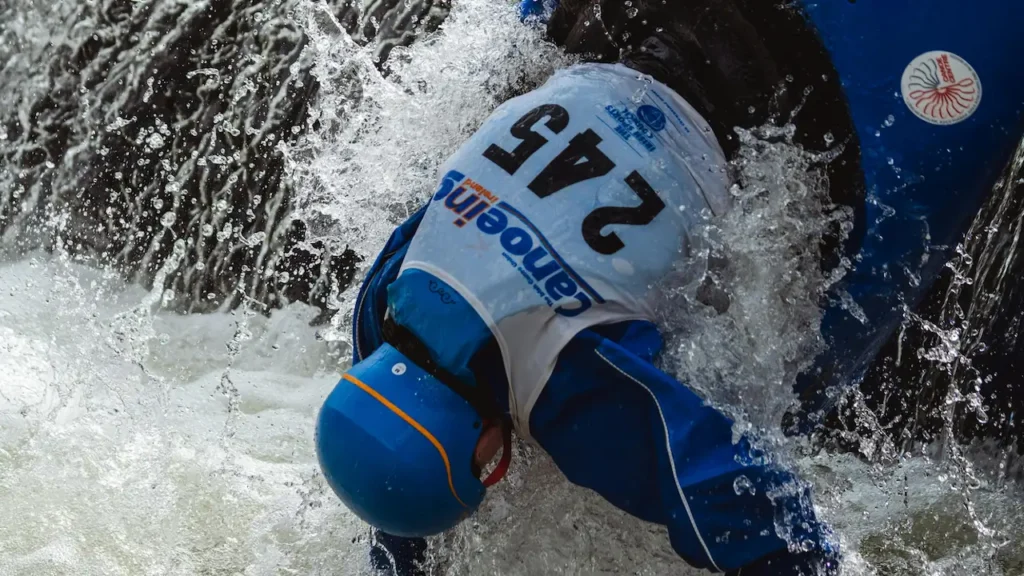What is a Touring Kayak?
A touring kayak is designed for longer journeys. It provides a combination of performance, comfort, and stability. Touring kayak is built to handle diverse environments and extended trips. This kayak is typically longer, narrower, and equipped with features that enhance speed, tracking, and storage capacity. It is ideal for paddlers seeking adventure beyond casual day trips.
In this article, we’ll explore what makes a touring kayak unique, its design features, and why it’s a great option for those looking to take their kayaking experience to the next level.
Key Features of Touring Kayak
Here are the key design features of touring kayaks:
Shape of Touring Kayak
Touring kayaks typically range from 12 to 18 feet. Longer kayaks offer better speed and tracking.
They usually have a narrow, streamlined hull. This reduces drag, and allows for faster paddling and efficient movement through the water.
V-shaped hull: Common in touring kayaks. it provides excellent tracking and helps the kayak slice through waves.
Flat-bottomed hulls: Provide more stability, though sacrifice some tracking.
Better Stability for Rough Water
Touring kayaks are designed with a balance of primary and secondary stability:
Primary stability refers to the kayak’s resistance to tipping when it is flat in the water (side-to-side stability).
Secondary stability comes into play when the kayak is leaned over or tilted.
Touring kayak is less stable than recreational kayaks. But they have better secondary stability, which is crucial for handling rough conditions.
Easily Accessible Storage Capacity
Touring kayaks have sealed compartments (bulkheads) at both the bow and stern. These bulkheads create watertight storage areas.
The kayak features hatch covers that can be easily opened or sealed to access gear.
The top of the kayak is equipped with bungee cords or rigging. This allows for securing additional gears like paddles, water bottles, and other essentials for quick access.
Cockpit Design to Make Your Seating Adjustable for Long Journey
The cockpit in a touring kayak is larger than in a racing kayak. This provides better comfortability during long hours of paddling.
Touring kayaks have adjustable seating to ensure a custom fit, with comfortable, padded seats, adjustable backrests, and foot pegs for supporting different leg lengths.
Touring kayaks are designed with a cockpit rim. This can hold a spray skirt. It prevents water from entering during rough conditions.
Durability of Different Material Used in Touring Kayak
Fiberglass is light but strong, and commonly used in higher-end touring kayaks. Kayak made with fiberglass offers excellent speed and performance.
Kevlar is Lightweight and durable. This is expensive and used in high-performance touring kayaks.
Rotomolded Plastic is more affordable, and slightly heavier than fiberglass and Kevlar. It is durable and resistant to impacts.
Carbon Fiber is the lightest and most durable option. This material is very expensive and often used in high-performance kayaks.
Rudder and Skeg for Improved Stability
Many touring kayaks have a rudder to help steer the kayak. This is especially useful while paddling in currents.
Skeg in touring kayak provides stability and improves tracking without the complexity of a rudder. It is generally used in calm water where fine-tuned steering isn’t as necessary.
Longer Paddle Size for Efficient Strokes
The large cockpit size in touring kayak makes it easily accessible to enter and exit. This design also offers comfort for extended paddling.
The paddles are generally longer, usually 220–260 cm. The paddle size suits better for longer, and efficient strokes.
Heavy Weight Due to Construction Material
Touring kayaks are generally heavier than recreational kayaks. This type of kayak is made of heavy materials and have added storage capacity. However, modern designs come with reduced weight.
Most touring kayaks come with handles at both the bow and stern to make portaging easier.
Bow and Stern Design of a Touring Kayak
The front or bow of the kayak is usually pointed and narrow. This allows the kayak to cut through waves and chop more efficiently.
The rear is a bit wider. It provides more storage space and stability, and allows for better control in rougher conditions.
Footrests and Leg Position
Adjustable Footrests are a standard feature of touring kayak. It ensures paddlers of varying heights can find a comfortable paddling position.
Foot Braces allow for better leverage. This reduces strain on your legs during extended paddling sessions.
When You Should Choose a Touring Kayak
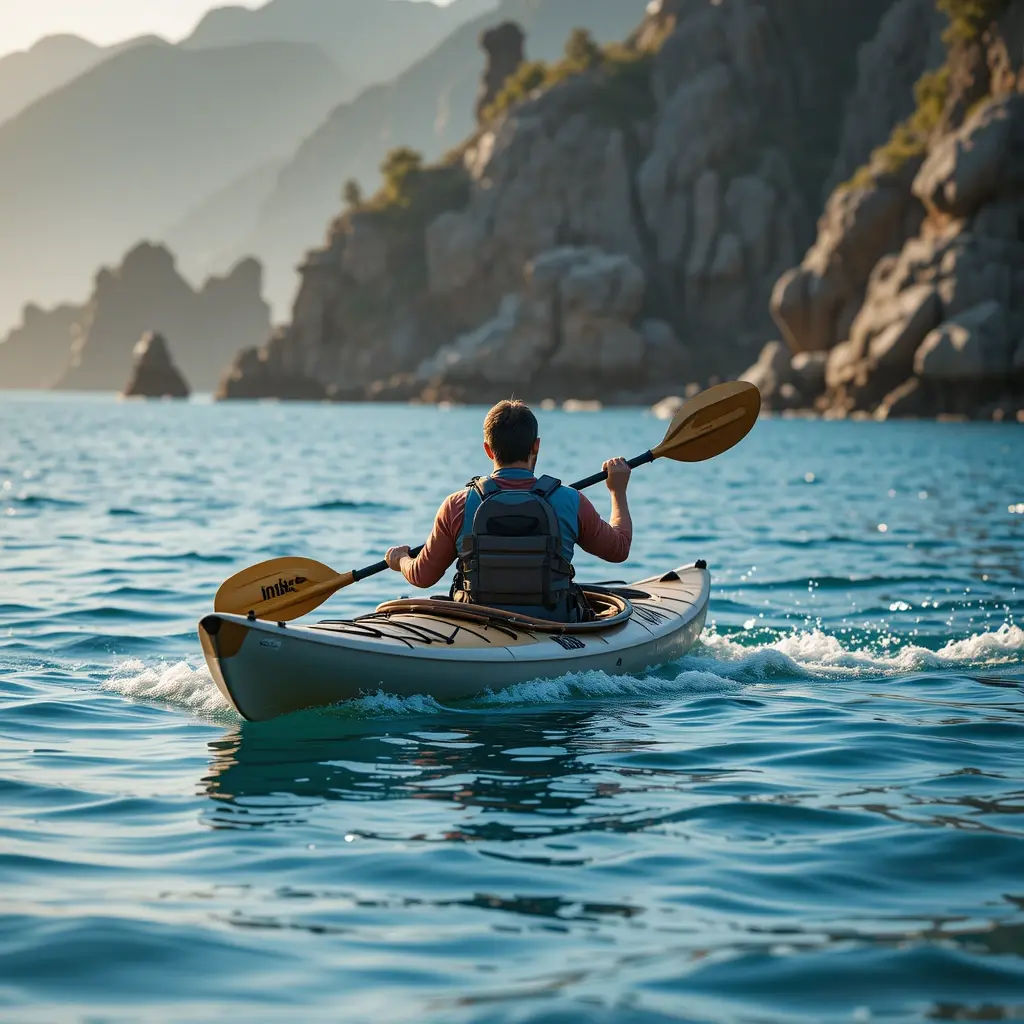
Here’s when you should choose a touring kayak:
Long-Distance Paddling: Touring kayaks are designed for extended paddling sessions. The ability to travel far and fast makes these kayaks the preferred choice for long-distance adventures on lakes, rivers, and coastal environments.
Multi-Day Expeditions: For multi-day kayaking trips or overnight expeditions, touring kayaks shine. They offer ample storage space for camping gear, food, and other essentials. The sealed compartments and bulkheads ensure that your gear stays dry and secure. Touring kayaks are ideal for carrying heavy loads and handling different weather conditions on long journeys.
Paddling in Challenging Conditions: Touring kayaks are designed to perform well in challenging conditions. These kayaks can perform well in choppy waters, rough seas, and rivers with moderate current. Thanks to their longer length, narrow hulls, and V-shaped design, they maintain excellent tracking and glide smoothly through waves.
You’re an Experienced Paddler Looking for Performance: Touring kayaks are generally designed for experienced paddlers. These kayaks offer superior performance and control compared to recreational models. With features like adjustable rudders, skegs, and hull designs, these kayaks allow experienced paddlers to adjust to different conditions, and optimize strokes.
Essential Accessories for Touring Kayaking
Touring kayaking involves long trips, and varying water conditions. Having the right gear for safety, comfort, and convenience is essential in touring kayak. Below is a detailed list of must-have accessories for touring kayaking.
Safety Equipment
Safety is the top priority when embarking on any kayaking trip.
A high-quality, kayaking-specific PFD is essential for safety and should be comfortable for long hours of wear. Look for features like pockets for small items. Choose designs that allow free arm movement for paddling.
A bilge pump helps you remove water from the cockpit. A sponge can help to soak up residual water that the pump can’t reach.
A spray skirt seals prevent water from entering during rough conditions and rain.
A loud whistle is crucial for signaling others in case of an emergency. You can carry flares or other signaling tools to be rescued when necessary.
Pack a waterproof first aid kit with essentials. Keep bandages, antiseptic wipes, and pain relievers in your first aid box.
A towline allows you to assist other kayakers in need, while a throw bag provides a rope for rescue situations.
A compass and marine charts are crucial for orientation in unfamiliar locations. GPS devices or apps can complement these tools.
Paddling Gear
A lightweight, durable paddle is critical for long-distance kayaking. Adjustable paddles allow for customization of blade angles. It reduces fatigue.
Always carry a spare paddle in case your primary paddle breaks or is lost. Two-piece or foldable paddles are ideal for easy storage.
Storage Solutions
Use dry bags to keep clothing, electronics, and dry food.
A waterproof deck bag offers quick access to essentials like snacks, maps, and cameras.
These add an extra layer of waterproofing and protect items stored in your kayak’s compartments.
Comfort Accessories
A padded seat or cushion make long paddling sessions comfortable, and reduce strain on your back and hips.
Wear water shoes or neoprene boots for foot protection during launches and landings. They also provide warmth in colder conditions.
A wide-brimmed hat, sunglasses with a retainer strap, and sunscreen are essential to protect against sunburn and glare off the water.
Paddling gloves protect your hands from blisters and offer warmth in cooler weather.
Hydration and Nutrition
A water bottle with a tube allows you to stay hydrated without interrupting your paddling.
Pack lightweight, non-perishable snacks like trail mix, energy bars, or jerky to maintain your energy levels during long trips.
Clothing and Weather Gear
Wear a drysuit for cold water paddling or a wetsuit for moderate conditions. Layer clothing underneath for added warmth.
A lightweight, waterproof jacket and pants protect you from rain or splashing waves.
Always pack a change of clothes in a dry bag, including moisture-wicking base layers and warm fleece for colder conditions.
Electronics and Communication
Protect your phone with a waterproof case.
A handheld marine VHF radio is essential for communication in open water and remote locations where cell service is unavailable.
Waterproof headlamp or flashlight is invaluable for visibility during low-light conditions.
Camping and Overnight Gear for Multi-Day Trips
A compact, waterproof tent and lightweight sleeping bags are essential for overnight stays. Use a sleeping pad for added comfort.
Bring a small camping stove, utensils, and lightweight cookware for preparing meals on shore.
Use bear-proof containers and odor-proof bags for storing food in areas where wildlife is a concern.
A versatile tool and knife can be used for gear repairs, and food preparation.
Maintenance and Care for Touring Kayaks
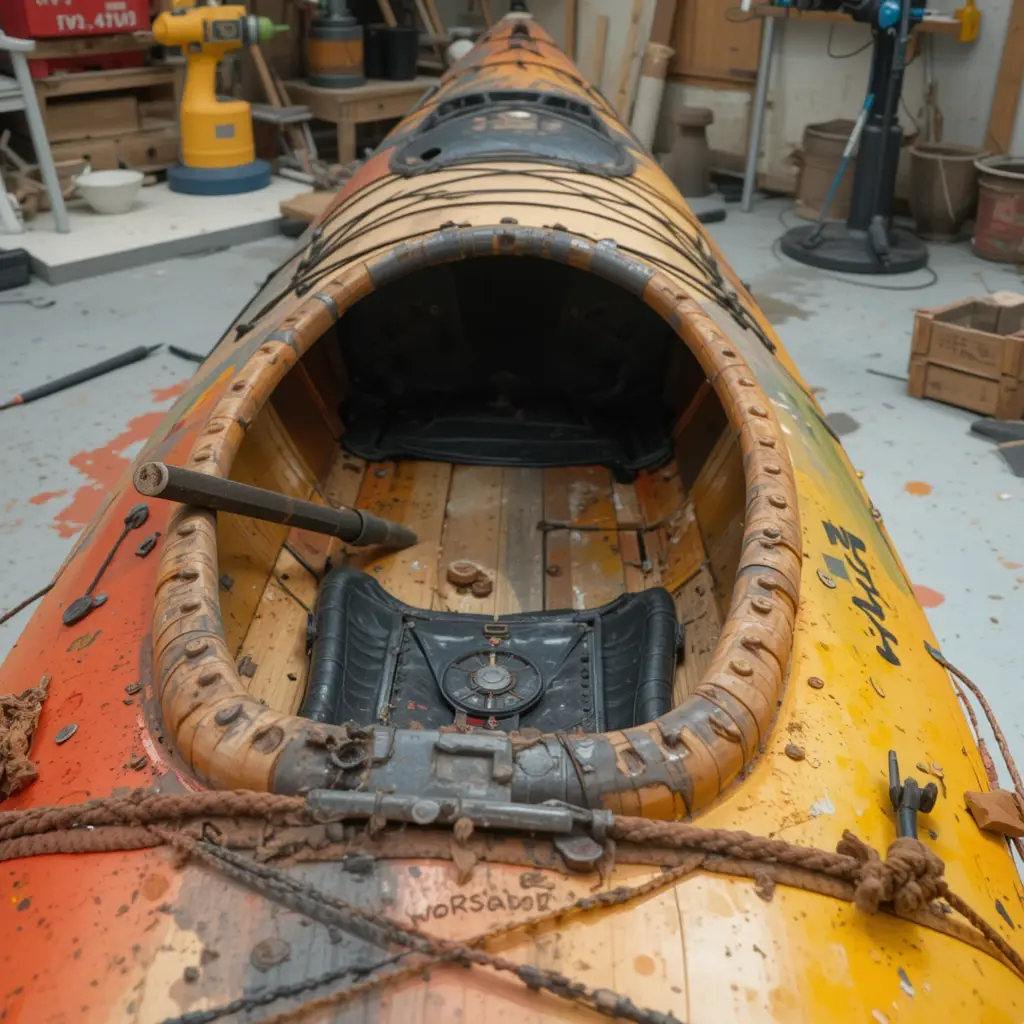
Proper maintenance helps ensuring longevity, safety, and performance. Below are some tips and guidelines for maintaining your touring kayak before, during, and after use.
Cleaning Your Kayak:
Salt and other debris can corrode metal components and damage materials over time. After paddling, rinse your kayak thoroughly with fresh water.
Pay extra attention to areas around hatches, rudders, and foot pedals where sand and dirt can accumulate.
For deeper cleaning, use a mild soap with a soft sponge. Avoid harsh chemicals.
Give your kayak a thorough cleaning at the end of the paddling season to remove any built-up grime, algae, and mildew.
Storing Your Touring Kayak:
Proper storage is key to preventing warping, cracking, and UV damage.
Prolonged UV exposure weakens and fade the material of your kayak. Store it indoors and protect it under a cover.
Use padded supports, slings, and racks to evenly distribute the kayak’s weight. Avoid placing it directly on the ground or on hard surfaces.
Inspecting for Damage:
Inspect for cracks, dents, and deep scratches.
Ensure that all hatches and bulkheads are watertight and free from damage.
Check for proper function and ensure there are no obstructions.
Tighten any loose screws, bolts, and fittings.
Repairing Your Kayak:
Use a heat gun to smooth out dents in rotomolded kayaks. Shallow scratches can be sanded lightly with fine-grit sandpaper.
Fill minor scratches with gel coat repair kits and resin.
Use a plastic weld kit or adhesive designed for polyethylene.
Repair cracks with fiberglass and epoxy resin.
Choosing the Right Touring Kayak
Your choice depends on several factors including experience level, intended use, water conditions, and personal preferences. Below are key factors to consider when choosing the perfect touring kayak for your needs.
Kayak Length and Hull Shape
12 to 14 feet: Best for short to medium trips on lakes, rivers, and sheltered coastal areas. They are easier to maneuver but offer less speed and tracking compared to longer kayaks.
14 to 16 feet: Ideal for multi-day tours and moderate open-water conditions. These kayaks provide a good balance between maneuverability, tracking, and speed.
16 to 18 feet: Perfect for long-distance touring, open water, and coastal paddling. They are faster, efficient, and better at tracking.
V-shaped Hull: Common in touring kayaks, the V-shaped hull enhances tracking, stability, and performance in waves. It’s great for open-water paddling.
Flat-bottom Hull: Offers more initial stability and is good for calmer waters. However, it may sacrifice some tracking and speed compared to a V-shaped hull.
Shallow Arch Hull: Provides a good balance between initial stability and performance, offering excellent tracking and some stability in calm waters.
Materials and Durability: Touring kayaks are made from different materials, each offering varying levels of durability, weight, and performance.
Plastic (Polyethylene): Highly durable and resistant to impacts. These materials are preferable for rocky rivers and rough shorelines. Generally heavier than composite kayaks. Affordable, ideal for budget-conscious buyers.
Composite (Fiberglass, Carbon Fiber, Kevlar): Lighter and faster but can be more prone to damage from impact. They are ideal for experienced kayakers. Lighter than plastic kayaks. Easier to carry and paddle over long distances. Expensive due to their high-performance materials.
Thermoformed Plastic: Lighter than polyethylene and more resistant to damage than fiberglass. Lightweight but not as light as composites. More expensive than polyethylene, but less expensive than composite kayaks.
Stability and Handling: A wider kayak will feel more stable, making it ideal for beginners. Kayaks with a V-shaped hull generally offer better stability.
Weight Capacity: Each kayak has a maximum weight capacity, which includes your body weight, gear, and any other equipment. Make sure the kayak you choose has a weight capacity that comfortably accommodates you and your gear. If you’re carrying a lot of gear for multi-day trips, look for a kayak with a higher weight capacity.
Cockpit and Comfort Features: Ensure the cockpit is large enough to allow for easy entry and exit. Look for kayaks with adjustable seats and lumbar support. Choose touring kayaks with adjustable footrests.
Intended Use
Consider the following questions to determine your needs:
- Where will you primarily paddle? (lakes, rivers, coastal waters, or open ocean)
- How far do you plan to travel? (short day trips, multi-day expeditions)
- Do you prioritize speed, stability, or comfort?
- What conditions are you likely to encounter? (calm waters vs. rough seas, currents, wind)
Popular Brands and Models of Touring Kayaks
There are many well-regarded brands in the touring kayak market, each offering models designed for different needs, conditions, and paddler skill levels. You can navigate the brands below for your best touring kayak.
Wilderness Systems: They offer Pungo 120, Tempest 165, Tsunami 145
Perception Kayaks: Conduit 13.0, Carolina 14.0, Zegul
Old Town Canoe and Kayak: Dirigo 120, Casco Bay 12.0, Loon 126
Necky Kayaks: Looksha 12, Manitou 14, Chatham 17
Frequently Asked Questions (FAQs) about Touring Kayaks
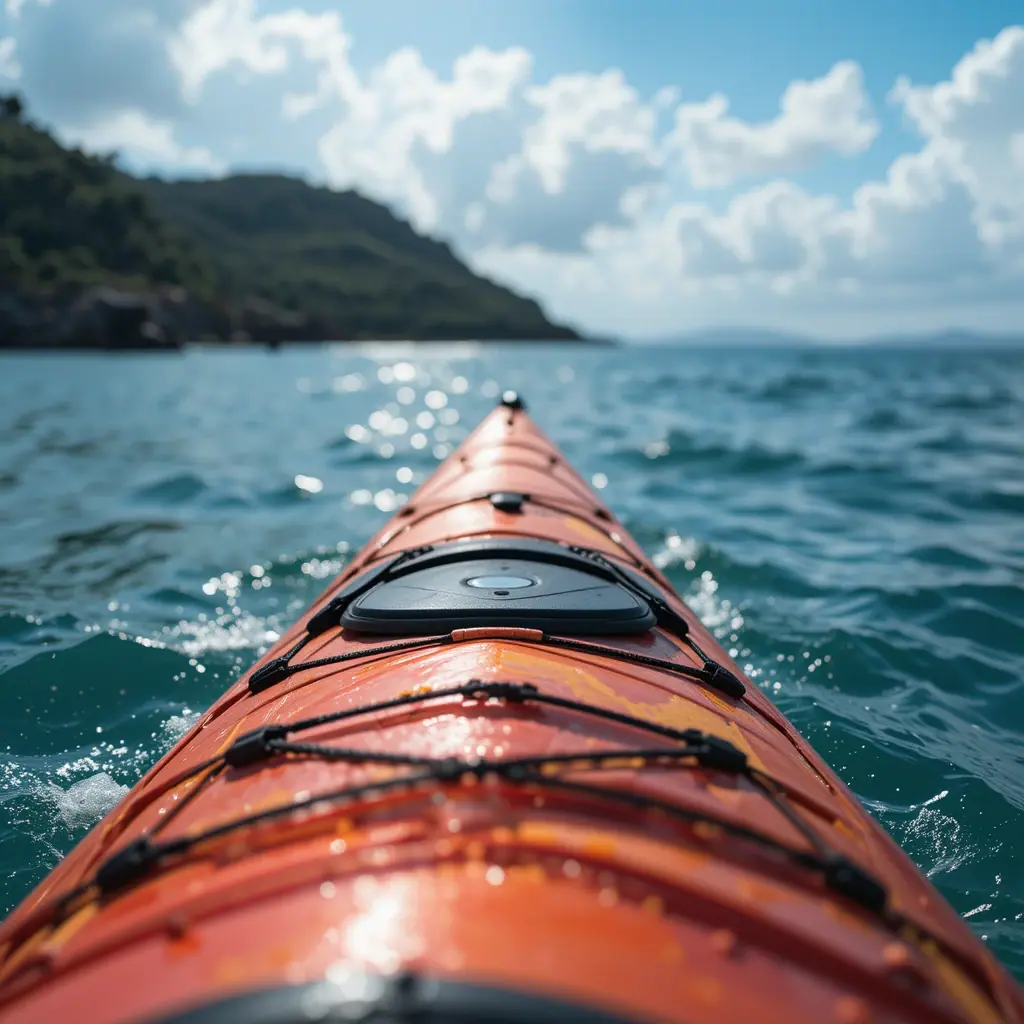
Do I need a rudder or skeg on my touring kayak?
If you primarily paddle in calm, sheltered waters and don’t mind adjusting your paddle strokes, a skeg is sufficient. If you’re paddling in open waters or areas with strong winds and currents, a rudder would be advantageous.
How much weight can a touring kayak carry?
Touring kayaks have weight limits. The average weight capacity of a touring kayak is between 250 and 400 pounds (113 to 181 kg).
When choosing a kayak, make sure the weight capacity can comfortably support both your weight and your gear.
How can I transport a touring kayak?
The most common method is to transport your kayak on your vehicle’s roof using a kayak roof rack. Ensure the kayak is securely strapped down to avoid shifting during transport. For transporting multiple kayaks, a trailer can be a convenient option. Use a kayak trolley or cart to move your kayak from the vehicle.
How do I prepare for a multi-day kayaking trip?
When embarking on a multi-day kayaking adventure, preparation is key:
- Gear: Bring sufficient gear, including camping equipment (tent, stove, sleeping bag), food, water, and first-aid supplies. Store everything in waterproof dry bags.
- Planning: Plan your route, considering distances between campsites, weather conditions, and water levels. Check tide schedules if paddling along the coast.
- Navigation: Carry a map, compass, or GPS device to help you navigate, especially in unfamiliar areas.
- Safety: Always wear a personal flotation device (PFD) and ensure you have a whistle, flares, or a satellite phone for emergency communication.
What are the best conditions for touring kayaking?
Touring kayaks are designed for a variety of water conditions, but they perform best in:
Lakes, calm rivers, and sheltered coastal areas are perfect for leisurely touring trips.
Touring kayaks excel in open water conditions such as coastal and ocean paddling, where their speed and tracking come into play.
While they can handle moderate winds and waves, larger waves and strong gusts require additional skill and experience to navigate safely.
Avoid paddling in extremely rough weather, as it can lead to dangerous conditions for any kayaker,
Do I need to be an experienced paddler to use a touring kayak?
While touring kayaks are suitable for a wide range of skill levels, your experience will influence the type of kayak you should choose:
- Beginners: Choose a kayak that is shorter and more stable, with good maneuverability and comfort. Look for a model that offers a larger cockpit for easy entry and exit.
- Intermediate: You can handle longer and narrower kayaks, which offer better tracking and speed. Consider a model with additional storage for gear.
- Experienced paddlers: Advanced kayaks are typically longer, narrower, and more streamlined. These are designed for speed and efficiency on longer trips and in more challenging water conditions.


